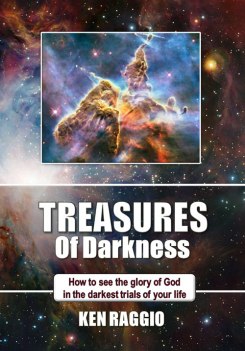SEE COMPLETE LIST OF ARTICLES ON HOME PAGE
 From The Upcoming New Book:
From The Upcoming New Book:
Treasures of Darkness
PREFACE
Blinded By The Light
by Ken Raggio
In late 1987, my wife and I took our two boys to the Fort Worth Museum of Science and History. Their new Omnimax theater was showing a spectacular new film about the Grand Canyon.
We sat up high in the state-of-the-art IMAX facility and watched as we took an aerial tour by helicopter of the Colorado River and an hour's worth of breath-taking views of the Grand Canyon. The giant 120-foot concave screen put the audience right in the center of a 180-degree view of sights that utterly defied description. It was like riding a helicopter through the Grand Canyon in real life -- if not more exciting!
When the film was over, the museum host gave a demonstration of the high-tech features of the domed theater, one of the largest of its kind in the world. While we remained in our seats, the huge screen suddenly went completely dark. Then the lights came on BEHIND the screen, and we could see THROUGH the screen into the huge room behind it.
There in the "backstage," we could see the massive framework supporting the screen, plus 72 huge speakers, grouped in ten clusters, with a total of 18,600 watts of audio power. We could see the entire building behind the screen -- the walls, the staircases, the lighting system and all the support systems that otherwise could not be seen.
That experience was amazingly similar to an event that takes place every night at sundown.
All day long, the sun's bright light shines into the earth's atmosphere, illuminating the whole earth below. Because the earth's atmosphere is predominantly composed of nitrogen and oxygen and hydrogen, the light reflects on those molecules, and the color we see is "sky blue."
In the blue sky, the light allows us to see the clouds drifting by, the birds on their wings, perhaps a jet flying high above, or a child's balloon gone astray. Whatever happens to be in the sky, we can see it because it is daytime, and the sunlight reveals it.
As the sun lowers in the sky, the light travels through many more miles of atmosphere along the horizon. Because the light is traveling lower and closer to the earth, the carbon dioxide content in the air reflects a red tint. That is why the sunsets are such magnificent colors of red and purple.
But at night, when the sun disappears below the horizon, and the sky is no longer illuminated, another spectacular scene unfolds.
Behind the "screen" of blue sky, which by night is invisible, there is an infinite depth of space that comes into view. On a clear night, scientists say we can see approximately 2,500 stars with the naked eye. More accurately, however, many of the stars are not stars at all, but entire galaxies of stars. In our galaxy alone, scientists declare there are over 100 billion stars. Multiply that by over 100 billion galaxies!
In 1975, the Apollo Soyuz space mission traveled beyond the earth's atmosphere to the edge of space. While there, astronauts photographed things that no scientist ever expected to see. An extreme ultraviolet telescope detected white dwarf stars that no one knew existed.
Before that time, scientists supposed that there were too many gaseous atoms in space to allow light to travel uninterrupted into earthly view. The light rays, they assumed, would be diffracted, and we would never see images of the farthest-distant heavenly bodies.
However, they discovered that in the vicinity of the sun, there is only one gaseous atom per hundred cubic centimeters out to at least two hundred "light years" away. What scientists called "the vicinity of the sun" was 200 times 5.88 trillion miles per light year -- for 1,176 trillion miles!
Today, thanks to the orbiting Hubble telescope, images are being captured of galaxies that scientists claim are many BILLIONS of light years away. Only because the Hubble operates above and away from the bright atmosphere of the earth is it capable of seeing into the deepest darkness of space.
Herein is a profound principle.
Many of the universe's greatest mysteries can only be seen in the darkest darkness. Otherwise the view is blinded by the light.
Transpose this principle into the spiritual universe and you have an equally fascinating maxim. The temporal lights of our material world have a blinding effect on the eternal treasures of God's spirit world. In a word, you can't see the heavens for the sky. The mesmerizing things in this present, carnal world (including our greatest pleasures and successes) block our view of infinitely more glorious things in the vast world of God.
If you want to see the most glorious works of God, you will have to turn the lights off.
Only in the dark can you see the treasures of darkness. In this book, I intend to take you on a most unique star trek -- into the treasures of God's darkness. I hope to teach you things that will enable you to see in the dark. You cannot believe -- yet -- what you will see.
Almost everybody everywhere believes that invisible forces are at work in our lives. The million-dollar question is, "What are those invisible forces?" I say that the greatest of all invisible forces is the Spirit and Power of Almighty God.
In this book, I intend to try to help you pull back the curtain and see some of those wonders that you have never seen before.
Until now, many of those invisible forces have been hidden. But when you turn out the lights, you will begin to see things that you never could imagine.
I challenge you to stay close as we venture into the great unknown. Do not be afraid. Wonderful things await.
But first, turn out the lights.
I am continually writing new content for this site.
Please return often for more material,
and tell your friends about
www.kenraggio.com
, too!
THANKS!
And God bless you!
Ken Raggio

|
|



